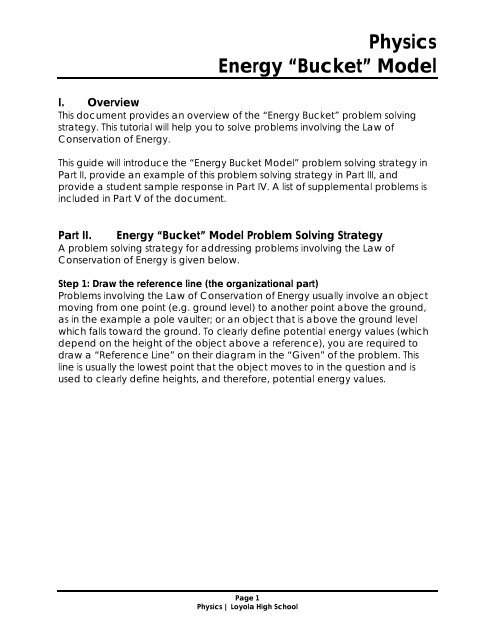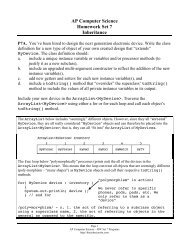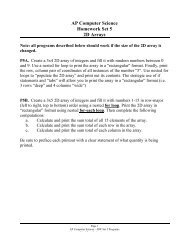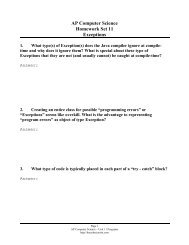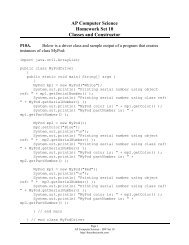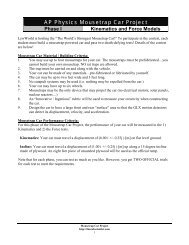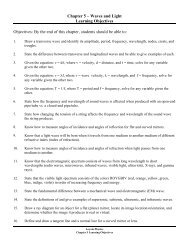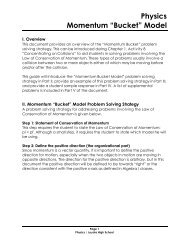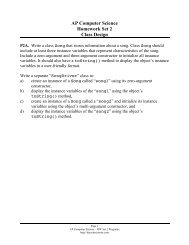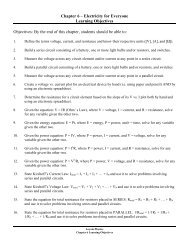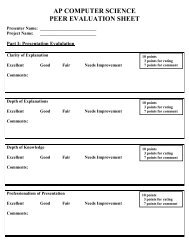Physics Energy “Bucket” Model - thecubscientist.com
Physics Energy “Bucket” Model - thecubscientist.com
Physics Energy “Bucket” Model - thecubscientist.com
You also want an ePaper? Increase the reach of your titles
YUMPU automatically turns print PDFs into web optimized ePapers that Google loves.
<strong>Physics</strong><br />
<strong>Energy</strong> <strong>“Bucket”</strong> <strong>Model</strong><br />
I. Overview<br />
This document provides an overview of the “<strong>Energy</strong> Bucket” problem solving<br />
strategy. This tutorial will help you to solve problems involving the Law of<br />
Conservation of <strong>Energy</strong>.<br />
This guide will introduce the “<strong>Energy</strong> Bucket <strong>Model</strong>” problem solving strategy in<br />
Part II, provide an example of this problem solving strategy in Part III, and<br />
provide a student sample response in Part IV. A list of supplemental problems is<br />
included in Part V of the document.<br />
Part II. <strong>Energy</strong> <strong>“Bucket”</strong> <strong>Model</strong> Problem Solving Strategy<br />
A problem solving strategy for addressing problems involving the Law of<br />
Conservation of <strong>Energy</strong> is given below.<br />
Step 1: Draw the reference line (the organizational part)<br />
Problems involving the Law of Conservation of <strong>Energy</strong> usually involve an object<br />
moving from one point (e.g. ground level) to another point above the ground,<br />
as in the example a pole vaulter; or an object that is above the ground level<br />
which falls toward the ground. To clearly define potential energy values (which<br />
depend on the height of the object above a reference), you are required to<br />
draw a “Reference Line” on their diagram in the “Given” of the problem. This<br />
line is usually the lowest point that the object moves to in the question and is<br />
used to clearly define heights, and therefore, potential energy values.<br />
Page 1<br />
<strong>Physics</strong> | Loyola High School
Step 2: Write statement of COE<br />
Here you will state the Law of Conservation of <strong>Energy</strong>:<br />
EA = EB<br />
In addition to writing this statement, you will clearly label where “A” and “B” are<br />
in the diagram. This might be right before a ball is shot up into the air, the highest<br />
point a ball goes when shot up into the air, etc.<br />
Step 3: Draw Buckets (the <strong>Physics</strong> part)<br />
Problems involving the use of the Conservation of <strong>Energy</strong> always involve a<br />
“beginning point” and an “end point”. In the example of a pole vaulter who has<br />
kinetic energy just before he leaves the ground and possesses gravitational<br />
potential energy at the top of his vault (where he is momentarily at rest), the<br />
“beginning point” is the instant before he leaves the ground and the “end<br />
point” is the instant when he is at his maximum height and, for a instant, has no<br />
velocity or kinetic energy.<br />
The next step of the <strong>Energy</strong> Bucket model requires students to draw the following<br />
set of buckets and identify which forms of energy are present at the “beginning<br />
point” or “A” and “end point” or “B” as described above. The definition of each<br />
bucket is presented below.<br />
Note that the Wf (work done by friction) “drip pan” is used to “capture” energy<br />
that is spilled in “pouring” energy from the PEg bucket to the KB bucket (if air<br />
resistance or other frictional forces are present), to account for all “energy<br />
losses”.<br />
=<br />
KA<br />
PEgA<br />
PESA<br />
KB<br />
PEgB<br />
PESB<br />
Wf<br />
The “A” and “B” subscripts represent the “beginning point” and “end point”<br />
respectively.<br />
KA = the kinetic energy at point A [J]<br />
PEgA = the gravitational potential energy at point A [J]<br />
PESA = the spring potential energy at point A [J]<br />
KB = the kinetic energy at point B [J]<br />
PEgB = the gravitational potential energy at point B [J]<br />
PESB = the spring potential energy at point A [J]<br />
Wf = the work done by frictional forces [J]<br />
Page 2<br />
<strong>Physics</strong> | Loyola High School
Step 4: Write <strong>Energy</strong> Equation (the mathematical part)<br />
After filling in the buckets according to which energies are present at the<br />
beginning and end points, the corresponding energy equation can be written.<br />
Step 5: Solve (the mathematical part)<br />
After <strong>com</strong>pleting Step 4, the known and unknown variables will be listed. If step<br />
4 is <strong>com</strong>pleted correctly, this step concludes with the solving of the algebraic<br />
equation for the unknown variable. As mentioned above, this step is a purely<br />
mathematical step, using math as a tool to arrive at the correct answer. The<br />
following section models how this strategy can be used to solve a Conservation<br />
of <strong>Energy</strong> problem.<br />
Page 3<br />
<strong>Physics</strong> | Loyola High School
Part III. Example Conservation of <strong>Energy</strong> Problem<br />
An 0.5 kg ball is dropped from rest from a height of 50 m above the ground.<br />
a) What is the velocity of the ball right before it hits the ground assuming no air<br />
resistance. b) What is velocity of the ball right before it hits the ground if 100 J of<br />
energy are lost due to air resistance?<br />
Given:<br />
A<br />
50 m<br />
Find: a) vB (no air resistance)<br />
b) vB (with air resistance)<br />
Solution:<br />
B<br />
ground level<br />
RL<br />
PART A:<br />
1. Draw the reference line<br />
Since the lowest point that the ball reaches in this problem is the ground, the<br />
letters “RL” are drawn in the diagram at the ground level in the “Given”. This<br />
defines where all heights, and therefore, gravitational potential energies will be<br />
measured from.<br />
2. Write statement of COE<br />
Here we write:<br />
EA = EB<br />
Note that the points “A” and “B” have been identified and labeled in the<br />
“Given”.<br />
Page 4<br />
<strong>Physics</strong> | Loyola High School
3. Draw <strong>Energy</strong> buckets<br />
Let’s address each of the energy buckets separately:<br />
KA = Is the object moving at point A? No, so bucket is not filled in<br />
PEgA = Is the object above the RL? Yes, so it has PEg, so we fill in the bucket<br />
PESA = Is a spring stretched or <strong>com</strong>pressed? No, so bucket is not filled in<br />
KB = Is the object moving at point B? Yes, so we fill in the bucket<br />
PEgB = Is the object above the RL? At point B, it is NOT, so we do not fill in<br />
the bucket<br />
PESB = Is a string stretched or <strong>com</strong>pressed? No, so bucket is not filled in<br />
Wf = Is friction or air resistance acting? No, so bucket is not filled in<br />
Therefore, we fill in the buckets as shown below:<br />
=<br />
KA<br />
PEgA<br />
PESA<br />
KB<br />
PEgB<br />
PESB<br />
Wf<br />
It is important to address HOW energy got into the PEgA bucket in the first place.<br />
Someone or something had to lift the object above the ground a certain<br />
distance. That is, a force was applied to the object over a certain distance, or<br />
Work was done ON the object to give it the energy.<br />
4. Write <strong>Energy</strong> Equation<br />
If the energies at points “A” and “B” are “filled in” correctly, then we can write<br />
the resulting Conservation of <strong>Energy</strong> equation:<br />
mgh<br />
A<br />
=<br />
1<br />
2<br />
mv<br />
2<br />
B<br />
5. Solve<br />
Again, this step is purely a mathematical step. If the correct buckets have been<br />
filled in (conceptual <strong>Physics</strong> <strong>com</strong>ponent) and the correct equation has been<br />
written, then the solution of vB is as follows:<br />
v = 2gh = 2(9.8)(50) = 31.3[ m/ s]<br />
B<br />
A<br />
Page 5<br />
<strong>Physics</strong> | Loyola High School
PART B:<br />
1. Draw the reference line<br />
Since the ball moves to the same level, the RL does not change. It remains at<br />
ground level.<br />
2. Write statement of COE<br />
Here we write:<br />
EA = EB<br />
Note that the points “A” and “B” have been identified and labeled in the<br />
“Given”.<br />
3. Draw <strong>Energy</strong> buckets<br />
At point “A” we only have UgA, therefore we fill that bucket with energy. At point<br />
“B” we have only KB, therefore we fill that bucket only. However, some energy is<br />
“lost” due to work done by air resistance (i.e. some energy is spilled into the “drip<br />
pan”), therefore we show that some energy is in the Wf “drip pan”. This illustrates<br />
that although some energy is “lost”, or more correctly, no longer in kinetic or<br />
potential form, all of the energy can be accounted for.<br />
=<br />
KA<br />
PEgA<br />
PESA<br />
KB<br />
PEgB<br />
PESB<br />
Wf<br />
4. Write <strong>Energy</strong> Equation<br />
If the energies at points “A” and “B” are correct, then we write the resulting<br />
Conservation of <strong>Energy</strong> equation:<br />
1<br />
mgh = mv + W<br />
2<br />
2<br />
A B air_<br />
resistance<br />
Page 6<br />
<strong>Physics</strong> | Loyola High School
5. Solve<br />
Again, this step is purely a mathematical step. If the correct buckets have been<br />
filled in (the conceptual <strong>Physics</strong> <strong>com</strong>ponent) and the correct equation has<br />
been written, then the solution of vB is as follows:<br />
v<br />
B<br />
( )<br />
( mgh W<br />
) ( )( )( )<br />
2<br />
2 0.5 9.8 50 100<br />
A air<br />
= = =<br />
m<br />
0.5<br />
24.08[ m/ s]<br />
The answer of 24.08 m/s is less than that without air resistance as it<br />
should be.<br />
Page 7<br />
<strong>Physics</strong> | Loyola High School
Part IV. Student Sample<br />
The sample problem below illustrates the use of the <strong>Energy</strong> Bucket <strong>Model</strong>.<br />
A block of mass m = 12 kg is released from rest on a frictionless incline of angle<br />
30 degrees. Below the block is a spring that can be <strong>com</strong>pressed 2.0 cm by a<br />
force of 270 N. The block momentarily stops when it <strong>com</strong>presses the spring by 5.5<br />
cm. (a) How far down does the block move down the incline from its rest<br />
position to this stopping point? (b) What is the speed of the block just as it<br />
touches the spring?<br />
Page 8<br />
<strong>Physics</strong> | Loyola High School
Part V. Supplemental Problems<br />
This problem set includes a selection of quantitative and qualitative problems<br />
involving Work and the Law of Conservation of <strong>Energy</strong>.<br />
Problems 1 and 2 refer to the figure below<br />
1. A frictionless roller-coaster car of mass m = 825 kg tops the first hill with a<br />
speed v0 = 17.0 m/s at height h = 42 m. What will be the car’s speed at<br />
point B?<br />
a. 12.34 [m/s]<br />
b. 20.28 [m/s]<br />
c. 26.46 [m/s]<br />
d. 33.21 [m/s]<br />
e. 41.60 [m/s]<br />
2. What will the car’s speed be at point C?<br />
a. 12.34 [m/s]<br />
b. 20.28 [m/s]<br />
c. 28.69 [m/s]<br />
d. 33.35 [m/s]<br />
e. 41.60 [m/s]<br />
Page 9<br />
<strong>Physics</strong> | Loyola High School
3. A block of mass m = 2.0 kg is dropped from height h = 40 cm onto a spring<br />
of spring constant k = 1960 N/m. Find the maximum distance the spring is<br />
<strong>com</strong>pressed.<br />
a. 2.2 [m]<br />
b. 1.4 [m]<br />
c. 1.0 [m]<br />
d. 0.7 [m]<br />
e. 0.1 [m]<br />
Page 10<br />
<strong>Physics</strong> | Loyola High School
Solution for #2 above<br />
(involves quadratic formula)<br />
Page 11<br />
<strong>Physics</strong> | Loyola High School
4. The figure below shows a ball with mass m = 3.0 kg attached to the end of<br />
a thin rod with length L = 2.5 m and negligible mass. The other end of the<br />
rod is pivoted so that the ball can move in a vertical circle. The rod is held<br />
horizontally as shown and then given enough of a downward push to<br />
cause the ball to swing down and around and just reach the vertical<br />
position, with zero speed there. What velocity did the push give the ball<br />
just as it left the horizontal position?<br />
a. 4.94 [m/s]<br />
b. 6.12 [m/s]<br />
c. 7.00 [m/s]<br />
d. 37.45 [m/s]<br />
e. 49.00 [m/s]<br />
Page 12<br />
<strong>Physics</strong> | Loyola High School
Problems 5 and 6 refer to the diagram below<br />
5. The spring of a projectile launcher (k = 500 N/m) is stretched back 0.25 m<br />
and shoots a ball of mass m = 3.4 kg off of a table. The launcher is 1.5<br />
above the ground level. What is the velocity of the ball just as it leaves the<br />
table?<br />
a. 10.81 [m/s]<br />
b. 9.19 [m/s]<br />
c. 3.03 [m/s]<br />
d. 1.50 [m/s]<br />
e. 0.71 [m/s]<br />
6. The ball hits a box a distance D from the base of the table. What is the<br />
distance D?<br />
a. 0.69 [m]<br />
b. 0.83 [m]<br />
c. 1.01 [m]<br />
d. 1.68 [m]<br />
e. 3.03 [m]<br />
Page 13<br />
<strong>Physics</strong> | Loyola High School
7. Two mice, Pinky and Brain, push against a stationary wall, Pinky stops after<br />
10 minutes, while Brain is able to push for 5 minutes longer. Compare the<br />
work they do.<br />
a. Pinky does 50% more work than Brain<br />
b. Brain does 50% more work than Pinky<br />
c. Pinky does 75% more work than Brain<br />
d. Neither of them do any work<br />
8. You lift a 10 N physics book up in the air a distance of 1m, at a constant<br />
velocity of 0.5 m/s. The work done by gravity is:<br />
a. +10 J<br />
b. -10 J<br />
c. +5 J<br />
d. -5 J<br />
9. The area under a curve, on a Force-position (F vs. x graph) represents:<br />
a. work<br />
b. power<br />
c. kinetic energy<br />
d. efficiency<br />
10. Which of the following curves illustrates Hooke's Law?<br />
11. A 10 kg mass, hung onto a spring, causes the spring to stretch 2 cm. The<br />
spring constant is:<br />
a. 49 N/cm<br />
b. 5 N/cm<br />
c. 0.2 N/cm<br />
d. 0.02 N/cm<br />
Page 14<br />
<strong>Physics</strong> | Loyola High School
12. Car A moves twice as fast as car B, and car A has half the mass of car B.<br />
The kinetic energy of car A, <strong>com</strong>pared to car B is:<br />
a. the same<br />
b. 2 to 1<br />
c. 4 to 1<br />
d. 1 to 2<br />
13. An acorn falls from a tree. Compare its kinetic energy K, to its potential<br />
energy PE due to gravity.<br />
a. K increases, and PEgravity decreases<br />
b. K decreases, and PEgravity decreases<br />
c. K increases, and PEgravity increases<br />
d. K decrease, and PEgravity increases<br />
14. Matthew pulls his little sister Sarah in a sled on an icy surface (assume no<br />
friction), with a force of 60 N at an angle of 37° upward from the horizontal.<br />
If he pulls her a distance of 12 m, the work he does is:<br />
a. 185 J<br />
b. 433 J<br />
c. 575 J<br />
d. 720 J<br />
15. A 4.0 kg box of fruit slides 8.0 m down a ramp, inclined at 30° from the<br />
horizontal. If the box slides down at a constant velocity of 5 m/s (with<br />
friction present), the work done by gravity is:<br />
a. zero<br />
b. +78 [J]<br />
c. -78 [J]<br />
d. +157 [J]<br />
e. -157 [J]<br />
16. A 200 g mass attached to the end of a spring causes it to stretch 5.0 cm. If<br />
another 200 g mass is added to the spring, the potential energy of the<br />
spring will be:<br />
a. the same<br />
b. twice as much<br />
c. 3 times as much<br />
d. 4 times as much<br />
Page 15<br />
<strong>Physics</strong> | Loyola High School
17. You throw a ball straight up. Compare the sign of the work done by<br />
gravity while the ball goes up with the sign of the work done by gravity<br />
while it goes down.<br />
a. Work up is +, and the work down is +<br />
b. Work up is +, and the work down is -<br />
c. Work up is -, and the work down is +<br />
d. Work up is -, and the work down is -<br />
18. How much work is done by gravity on the 1000 kg roller coaster as it<br />
moves from point Q to point R?<br />
a. 32,000 [J]<br />
b. 50,000 [J]<br />
c. 245,000 [J]<br />
d. 490,000 [J]<br />
e. 980,000 [J]<br />
19. If the roller coaster leaves point Q from rest, how fast is it traveling at point<br />
R? Ignore friction.<br />
a. 13.4 [[m/s]<br />
b. 22.1 [m/s]<br />
c. 31.3 [m/s]<br />
d. 490 [m/s]<br />
e. 980 [m/s]<br />
20. If the roller coaster leaves point Q from rest, what is its speed at point S (at<br />
the top of the 25 m peak)?<br />
a. 13.4 [m/s]<br />
b. 22.1 [m/s]<br />
c. 31.3 [m/s]<br />
d. 490 [m/s]<br />
e. 980 [m/s]<br />
Page 16<br />
<strong>Physics</strong> | Loyola High School
21. A container of water is lifted vertically 3 m, then returned to its original<br />
position. If the total weight is 30 N, how much total work was done by<br />
gravity?<br />
a. 45 [J]<br />
b. 90 [J]<br />
c. 0 [J]<br />
d. -45 [J]<br />
e. -90 [J]<br />
22. On a plot of F vs. x, what represents the work done by the force F?<br />
a. The slope of the curve<br />
b. The length of the curve<br />
c. The area under the curve<br />
d. The product of the maximum force times the maximum x<br />
23. A 1 kg flashlight falls to the floor. At the point during its fall, when it is 0.70<br />
m above the floor, its potential energy exactly equals its kinetic energy.<br />
How fast is it moving?<br />
a. 3.7 [m/s]<br />
b. 6.9 [m/s]<br />
c. 13.7 [m/s]<br />
d. 44.8 [m/s]<br />
e. 56.9 [m/s]<br />
24. A truck weighs twice as much as a car, and is moving at twice the speed<br />
of the car. Which statement is true about the truck's kinetic energy (K)<br />
<strong>com</strong>pared to that of the car?<br />
a. All that can be said is that the truck has more K<br />
b. The truck has twice the K of the car<br />
c. The truck has 4 times the K of the car<br />
d. The truck has 8 times the K of the car<br />
Page 17<br />
<strong>Physics</strong> | Loyola High School
25. A ball is released from rest at the left side of the loop-the-loop, at the<br />
height shown. If the radius of the loop is R, what vertical height does the<br />
ball rise to on the other side neglecting friction?<br />
Note: h is much higher than R<br />
a. Less than R<br />
b. R<br />
c. 2R<br />
d. Greater than 2R<br />
26. A spring is characterized by a spring constant of 60 N/m. How much<br />
potential energy does it store, when stretched by 1 cm?<br />
a. 0.003 [J]<br />
b. 0.3 [J]<br />
c. 60 [J]<br />
d. 600 [J]<br />
e. 6000 [J]<br />
27. You and your friend want to go to the top of the Eiffel Tower. Your friend<br />
takes the elevator straight up. You decide to walk up the spiral stairway,<br />
taking longer to do so. Compare the gravitational potential energy of you<br />
and your friend, after you both reach the top. Assume you and your friend<br />
weigh the same.<br />
a. Your friend's PEg is greater than your PEg, because she got to the<br />
top faster.<br />
b. Your PEg is greater than your friend's PEg because you traveled a<br />
greater distance getting to the top.<br />
c. Both of you have the same amount of potential energy<br />
d. It is impossible to tell, since the time and distances are unknown<br />
28. A skier of mass 40 kg pushes off the top of a hill with an initial speed of 4<br />
m/s. Neglecting friction, how fast will she be moving after dropping 10 m<br />
in elevation?<br />
a. 7.11 [m/s]<br />
b. 10.29 [m/s]<br />
c. 14.56 [m/s]<br />
d. 49.91 [m/s]<br />
e. 196.12 [m/s]<br />
Page 18<br />
<strong>Physics</strong> | Loyola High School
29. A simple pendulum, consisting of a mass m, is attached to the end of a 1.5<br />
m length of string. If the mass is held out horizontally, and then released<br />
from rest, its speed at the bottom is:<br />
a. 5.4 [m/s]<br />
b. 9.8 [m/s]<br />
c. 17 [m/s]<br />
d. 96 [m/s]<br />
30. A toy rocket, weighing 10 N, blasts straight up from ground level with a<br />
kinetic energy of 40 J. At the exact top of its trajectory, its total<br />
mechanical energy is 140 J. To what vertical height does it rise?<br />
a. 10 [m]<br />
b. 14 [m]<br />
c. 24 [m]<br />
d. None of the above<br />
31. King Kong falls from the top of the Empire State Building through the air to<br />
the ground below (air friction is present). How does his kinetic energy (K)<br />
just before striking the ground <strong>com</strong>pare to his potential energy (PE) at the<br />
top of the building?<br />
a. K is equal to PE<br />
b. K is greater than PE<br />
c. K is less than PE<br />
d. It is impossible to tell without knowing the mass of King Kong and the<br />
height of the building<br />
32. A 30 N stone is dropped from a height of 10 m, and strikes the ground with<br />
a velocity of 7 m/s. What average force of air friction acts on it as it falls?<br />
a. 22.5 N<br />
b. 75 N<br />
c. 225 N<br />
d. 293 N<br />
Page 19<br />
<strong>Physics</strong> | Loyola High School
33. The speed needed at the bottom of a loop-the-loop track so that a car<br />
can coast to the top, with sufficient speed to stay on the track, depends<br />
on the mass of the car. (Neglect the effects of friction and air resitance)<br />
a. Always true<br />
b. Never true<br />
c. Sometimes true, since kinetic energy is a function of mass<br />
d. Sometimes true, since potential energy is a function of mass<br />
34. An object is lifted vertically 2 m and held there. If the object weighs 120<br />
N, how much work was done in lifting it?<br />
a. 2352 [J]<br />
b. 240 [J]<br />
c. 0 [J]<br />
d. -280 [J]<br />
e. -2352 [J]<br />
35. A projectile of mass m leaves the ground with a kinetic energy of 220 J.<br />
At the highest point in its trajectory, its kinetic energy is 120 J. To what<br />
vertical height, relative to its launch point, did it rise?<br />
a. 220/mg [m]<br />
b. 120/mg [m]<br />
c. 100/mg [m]<br />
d. 50/mg [m]<br />
e. 25/mg [m]<br />
36. Which of the following is not a good example of potential energy?<br />
a. A man on the ledge of a building<br />
b. A stretched spring<br />
c. A car moving on a flat road<br />
d. Water at the top of a waterfall<br />
37. Describe the energy of a car driving up a hill.<br />
a. entirely kinetic<br />
b. entirely potential<br />
c. both kinetic and potential<br />
d. gravitational<br />
Page 20<br />
<strong>Physics</strong> | Loyola High School
<strong>Energy</strong> <strong>Model</strong> Answer Key<br />
1 C<br />
2 D<br />
3 E<br />
4 C<br />
5 C<br />
6 D<br />
7 D<br />
8 B<br />
9 A<br />
10 B<br />
11 A<br />
12 B<br />
13 A<br />
14 C<br />
15 D<br />
16 D<br />
17 C<br />
18 D<br />
19 C<br />
20 B<br />
21 C<br />
22 C<br />
23 A<br />
24 D<br />
25 D<br />
26 A<br />
27 C<br />
28 C<br />
29 A<br />
30 D<br />
31 C<br />
32 A<br />
33 B<br />
34 B<br />
35 C<br />
36 C<br />
37 C<br />
Page 21<br />
<strong>Physics</strong> | Loyola High School


